All about OSB boards

Today, most home craftsmen know what OSB-plates are, however, there are still many questions about deciphering the marking, harmfulness or safety of panels for human health, characteristics. Modern wood chip modules have practically replaced other panels in the structures of buildings and structures; they are reliable, durable, do not require complex fastening. A review of reviews and a comparison of OSB with plywood and other types of such boards will help to evaluate all the advantages of this material.
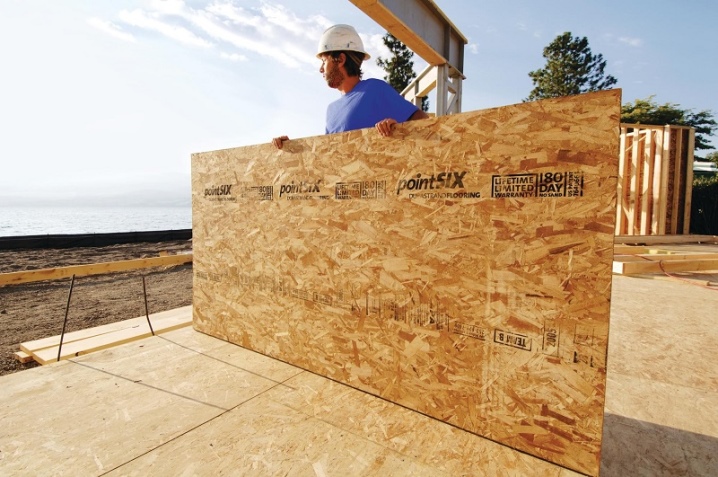
What it is?
OSB belongs to the category of wood building boards, their production and use are regulated by the requirements of GOST R 56309-2014. The decoding of the abbreviation in Russian sounds quite simple - wood boards with oriented shavings. OSB boards differ from other panels in their composition. Their structure is multi-layered, it is formed by connecting thin chips using resinous components on a synthetic basis. This composition provides high strength, material resistance to operational loads.
A flat oriented strand board is formed due to the different orientation of the layers. The outer layers have a longitudinal position, the rest are perpendicular to them.
Since the material consists of chips and shavings of natural wood, it partially retains its properties, additionally acquiring new possibilities.


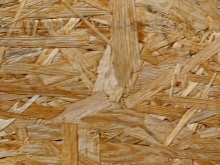
Like other building boards, OSB has its pros and cons. The advantages of the material include a number of characteristics.
- Strength. The slabs are made of multidirectional layers, the elements in them are rather large, so the panels are stronger than the usual options from small shavings and sawdust.
- Elasticity. Curved structures can be made from OSB slabs; they are suitable for creating arched openings and other elements of complex shapes. After pressing, the material returns to its previous shape.
- Uniformity, no defects. Plates do not have knots and other inclusions, like veneered materials, they are less susceptible to destruction.
- Stability of parameters. Resins in the composition make OSB resistant to short-term contact with moisture.
- Ease of machining. Sheets can be sanded, sawn, milled.
- Soundproof and heat-insulating properties. Walls made of such material drown out extraneous sounds, help to reduce the level of noise penetrating from the outside. The thicker the slab, the better it retains heat.
- Chemical and biological resistance. OSB boards are made on the basis of resins, so they are well protected from fungus and mold. The outer wax coating, applied at the factory, provides the material with sufficient moisture resistance.


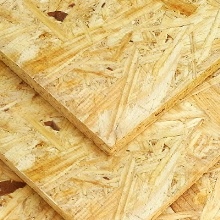
There are also disadvantages. The material has limited use in residential premises, since some of its classes do not meet international environmental standards due to the content of formaldehydes. The vapor permeability of wood-based panels is also not too high.
In addition, binder resins have a characteristic, rather pungent odor, which takes a long time to remove.



Characteristics and properties
OSB has a certain set of characteristics that determine its purpose and functionality. Not only the texture or structure of the boards, the size of the chips, but also other important parameters differ.



The main technical characteristics of the OSB are worth considering in more detail.
- Harmful to health. The environmental friendliness of the OSB is in great doubt. The main harm is caused by formaldehyde resins, the toxicity of which is quite high. But the percentage of these components in the composition is extremely low (up to 3%) in compliance with European standards. This is 4 times less than that of chipboard, from which furniture and furnishings are made.
- Water vapor permeability. Since the structure of the material is based on resins, it is not highly breathable. The vapor permeability of OSB boards is no more than 0.0031 mg (m * h * Pa). This is a very low figure, comparable to what foam glass or linoleum shows.
- Life time. Standard OSB boards, when used outdoors, can retain their properties for more than 10 years. Foreign experience shows that in the composition of roofing decks and floors, the coating has to be changed even less often. Its average service life exceeds 20 years.
- Moisture resistance. Regardless of its class, OSB is afraid of water - this is due to its composition. The degree of moisture resistance is determined by the ability of the material to swell when immersed in water for 24 hours. For OSB-1, this figure reaches 25%, for OSB-4 - only 12%.
- Flammability. OSB is a material belonging to the G4 class. This means that it is highly flammable and requires additional treatment with flame retardants. Boric acid is used as a fire retardant additive, but it does not fundamentally solve the problem.
- Thermal conductivity. OSB sheet is considered a good choice for the construction of buildings and structures. The main parameter of the material for the construction of walls, floors is the resistance to heat transfer. For OSB boards, this indicator, depending on the thickness, varies from 0.08 to 0.16.


These are the main characteristics that have to be taken into account when using oriented strand materials.
Description of species
OSB panels have their own classification, which includes a comparison of different characteristics and parameters of the material. The density and strength of the structure, the presence of decorative finishes are taken into account. It is worth learning more about what kind of oriented wood chip boards are.



By the appearance of the front side
OSB varieties are divided into several categories according to the availability and type of finish.
- With lamination. This option can be reused. Laminated OSB is used in the manufacture of reusable formwork when pouring a concrete monolith.
- Lacquered. Such boards can be used for interior decoration in a certain style or installed in rooms with high levels of humidity.
- With grinding. Well suited for decorative finishes. Used indoors.
- No sanding. It is used for external cladding of walls of buildings and structures.
Depending on the presence or absence of coating on the outside, OSB can be used in construction for the production of reusable formwork, suitable for subsequent finishing or used in its natural form.


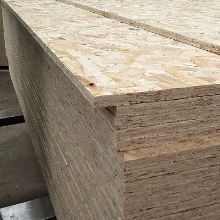
By strength
OSB panels can be classified according to their strength and quality characteristics. The material is divided into several categories.
- OSB-4. This class includes slabs with the highest strength indicators. Their reliability and environmental friendliness make the material suitable for use inside and outside buildings. It can withstand maximum operating loads.
- OSB-3. The most popular and widespread type of slabs. Suitable for use in humid environments.
- OSB-2. A class of material for indoor use. It can withstand minor operating loads and has medium strength. Not suitable for wet rooms.
- OSB-1. The most fragile class of plates. They are recommended for use in unloaded structures, without access to a humid environment.
This is the main classification applied to oriented strand board.

Dimensions and weight
The dimensions of OSB sheets are standardized. They are produced in the size of 1250 × 2500 mm (European standard) or 1220 × 2440 mm, they can have a large length when custom-made, for a specific project. The thickness ranges from 8 to 26 mm, in 2 mm increments. The mass also varies. With the same dimensions and an average density of 650 kg / m3, a 9 mm thick sheet will weigh 18.3 kg, and 15 mm will already weigh 30.5 kg.


Marking
The presence of special markers allows the manufacturer to inform the consumer about the properties and characteristics of the material. In addition, the markings sometimes contain instructions for installation. A number of important designations can be distinguished.
- W / R / F. These letters mark the purpose of the material: wall - for walls, floor - for floor, roof - for roof.
- Strength Axis This Direction. The inscription is complemented by an arrow indicating the transverse direction in which the slab should be placed.
- This Side Down. The markings indicate the bottom side when mounted horizontally.
- By country of origin. The abbreviation CSA stands for Canadian products, PS2-04 for American products, EN-300 for European products.
- Sheating Span. Indicates the distance between joists or frame posts.
These are the main designations found on the surface of OSB-type wood-based panels.



Popular manufacturers
OSB is produced today both in Russia and abroad. One of the main suppliers of such materials is the Austrian plant Kronospan, which has branches in Eastern Europe. In addition, the brands Louisiana Pacific from the USA, Glunz from Germany and Ainsworth from the USA and Canada are on the market. Chinese manufacturers cannot compete with them in any significant way because of the poor quality of raw materials, replacing conifers with softer poplar.
When choosing products from Russian manufacturers, it is also better to focus on the market leaders. These are DOK "Kalevala" in the Vladimir region and an enterprise in Torzhok, which produces OSB-3 and OSB-4 slabs.
And also one of the Kronospan factories operates in Russia.



Comparison with other materials
The OSB board, by its appearance on the building materials market, has significantly reduced the sales of other sheet panels. Of course, it is significantly inferior to solid wood lining and plywood as close as possible to it in terms of hardness and strength. The environmental safety of materials also differs, and not in favor of OSB. But if you compare building boards with each other, the difference will no longer be so significant.
For example, drywall and GVLV are almost twice as low as OSB in terms of moisture resistance. DSP by this indicator is practically equal to oriented strand board, and LSU is superior to all other materials. According to the G4 flammability class, OSB is on the same level as particleboard, fiberboard and MDF.
But it has a lower thermal conductivity coefficient, which ensures better heat retention in rooms.



Applications
OSB is a versatile building material used for work outside and inside buildings.

It is worth listing the main areas of its application.
- House cladding. The panels are used for exterior decoration and for the formation of internal partitions. Finishing materials are mounted on top of them.
- Installation of the subfloor. The shield is laid as a base on the logs. A board or other materials selected for arranging the rough covering are mounted on it.
- Formation of a continuous roofing base for hardfacing or soft building materials.
- Creation of support structures. Since the material can be used outdoors, I-beams and other elements necessary for construction are often made from it.
- Manufacturing of permanent and removable formwork for concrete. The frame assembled from OSB does not require complex construction. Removable formwork is made from laminated or sanded material options.
- Creation of hives, mailboxes, household chests, packaging containers.
- Crafts making. Original playhouses and playgrounds for children are made from OSB.
- SIP panels production. They are 2 sheets of OSB, connected with a heat-insulating layer of expanded polystyrene.
- Furniture manufacturing. High-quality materials OSB-3, OSB-4 are suitable for the manufacture of parts for cabinets, benches, chairs.
- Creation of advertising structures. Shields of this type are lightweight and have a large usable area.
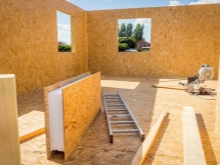


These are the main areas of application for OSB. And also the material can be found in other uses in the economy or in production.
Nuances of choice
OSB boards are on sale in a wide range. This somewhat complicates the final decision when purchasing.

The recommendations of specialists will help you to choose the right OSB correctly.
- Pay attention to the surface finish. Usually it has a smooth structure and a pronounced shine, but there are also matte options. This is not a processing defect - these slabs are made specifically for the roof. The rough structure ensures safe movement of the master on the roof. In addition, mastics, primers and materials to be welded are better placed on such a plate.
- Inspect edges. Plates with flat edges are mounted with additional support bars. They are designed for the assembly of vertically oriented structures. Modules with spikes and grooves on the edges not only provide better sealing, but also dispense with bridges. Such a connection is in demand for horizontal installation in the structure of the roof, floor, ceiling.
- Choose the right thickness. Slabs of 12-15 mm are considered the best solution for creating a continuous roof sheathing. Their bearing capacity is the highest. Panels with a thickness of 9.5-12.5 mm are designed for installation as wall cladding in frame building structures. Thinner slabs are used for filing ceilings, creating internal partitions.
- Use 2 layers instead of 1. For horizontal installation and operation under loads, it is better to take a thinner material, but lay it in tiers. This approach provides an opportunity to eliminate through gaps, helps to increase the strength of basement ceilings, floors and roof structures laid on logs.
- Consider the appointment. In terms of emission class, only E0 or E1 boards are suitable for interior decoration. The rest of the options are suitable only for outdoor use in the process of facing the outer walls of buildings and structures.
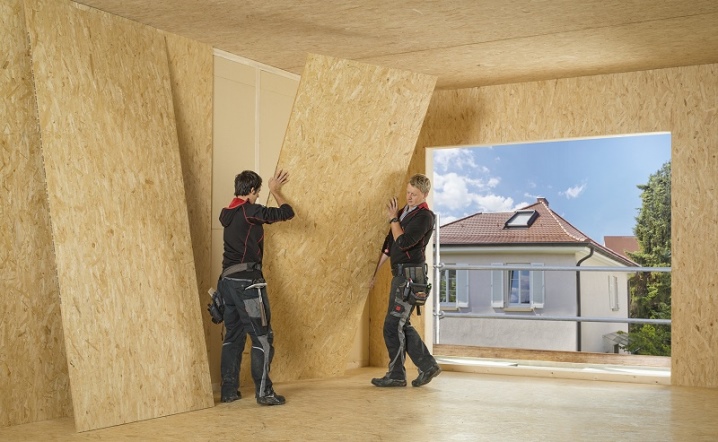
These are the main recommendations that are best taken into account when choosing OSB boards when buying them. In addition, it is important to remember the value for money. Saving is definitely not worth it.
It is better to immediately buy material from a well-known European brand that meets high environmental standards.

Review overview
According to buyers, OSB boards are a good alternative to plywood and other types of boards used in the arrangement of external and internal walls, floors, and ceilings. Their main application is limited to the facing of frame buildings and structures, since not all manufacturers are ready to manufacture products with a low formaldehyde content. Inside a house or apartment, slabs are used when arranging floors and ceilings, creating partitions. Buyers note that even after 10 years of service, such materials successfully perform their functions; with proper installation, they are not afraid of moisture, and remain resistant to the influence of the external environment.
Disadvantages are also noticed. When used as a facade coating, the protective wax must be removed from the slabs, and then treated with soil. Improper execution of these works leads to the fact that loopholes appear inside for the development of mold and mildew. When sawing, be sure to protect the edges.
And the material does not look attractive, it is only suitable for subsequent decorative finishing.














The comment was sent successfully.